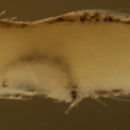en
names in breadcrumbs


Diagnosis: Modal fin-ray counts of D-VI,9 A-9 Pect-18 indicate Eleotris perniger. This species is almost identical (and can co-occur) with E. amblyopsis, but is reported to have a mode of 18 pectoral-fin rays with a range from 16 to 19 vs. a mode of 16 and a range of 15-18 for E. amblyopsis (Pezold 2002). This is the only eleotrid genus with as few as 8 or 9 second dorsal and anal-fin elements and equal numbers. Taxonomy is unresolved in this genus; E. perniger is mostly of the Antilles, but reportedly co-occurs with E. amblyopsis along the Central American coast. This larval type is from off Yucatan and has distinctively different markings along the dorsal-fin bases compared to typical E. amblyopsis larvae collected from Panama. It is identified as E. perniger pending DNA identification.
Analogues: The eleotrid larvae share a long thin body with relatively short dorsal and anal-fin bases, numerous procurrent caudal-fin rays, and a long ventral midline streak from the isthmus to the mid-abdomen.
Description: Body somewhat thick, long and narrow with a medium eye and a terminal medium-sized mouth. Pectoral fins short, reaching only about halfway to vent. Pelvic fins short and separate. Dorsal and anal-fin bases very short and the front and middle rays are longer than the back rays making a triangular outline to the fin, caudal peduncle relatively wide and long and there are many procurrent caudal-fin rays in a distinct fleshy fold, from 12-14 in this larval type. Dorsal markings are prominent along the dorsal-fin bases, as paired melanophore rows running alongside the base of both fins. Along the ventral midline, melanophores occur in streaks extending from the isthmus most of the way to the vent, but absent below the swim bladder (which is the full thickness of the abdomen and provides a clear view of the retroperitoneum). There is an irregular paired row of melanophores along the bases of the last seven or eight anal-fin rays and continuing as three or four streaks along the ventral midline of the peduncle ending at the start of the lower procurrent caudal-fin rays. The end of the caudal peduncle is uniformly covered by a wide bar of large melanophores, usually not reaching the bases of the upper and lower procurrent caudal rays. Melanophores extend out along the proximal lower segmented caudal-fin rays. Head markings include melanophores at the angle of the jaw, along and beside the dentary of the lower jaw and outlining the maxillary. Prominent melanophores extend over the surface of the iris on the dorsal half of the eyeball and paired around the base of the eyeball and, when expanded, melanophores almost cover the iris. Internal melanophores surround the saccule and are present along the dorsal surface of the swim bladder extending down to the vent. There is a linear internal melanophore above the pelvic girdle, perhaps along the ventral postcleithrum, and a few internal melanophores are often present around vertebral bodies near the tail and sometimes continuing along the hemal spine down to meet the midline melanophores.